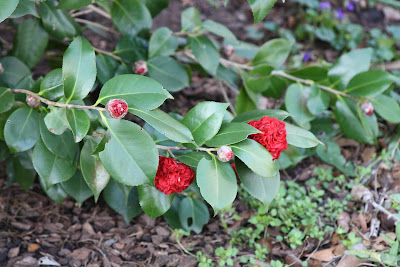Each time I purchase a garden book, I expect to enjoy it. Some I do. Some, not so much.
And then, there are the few that I truly savor. I drink in the enjoyment of reading each page. I relish each and every photo. I appreciate the way in which the topics are presented. And I delight in the wisdom of words by experienced gardeners.
Gardens Private and Personal:
A Garden Club of America Book
by Nancy D'Oench,
is a book that was meant to be savored, and I did.
This book accomplishes several things.
First, it educates one on garden design. It starts where anyone starts in touring a garden: from the gates and garden entrances. Just as if you were walking through a garden, the book moves you through a garden one chapter at a time. As you enter the gates, you ponder the views, which is the next chapter, then pathways (again, the next chapter), then areas of rest, etc. until you have experienced an entire garden tour. The catch? You have just toured over 90 gardens!
There is not a lot of instruction on garden design in the book, but it will make you look at your garden through new eyes - as a visitor sees your garden.
Secondly, I loved the way in which the book was composed. A short lesson at the beginning of each chapter is followed by photos of numerous gardens. Each photograph has an informational description. But most delightful is that also included are quotes from the gardener. It is as if you are touring the garden with the gardener themselves.
For instance, under the chapter "Steps", Page 44 shows a garden with terraced steps and plantings on either side.
The description of the photo states:
"This was a steep, oval amphitheater until Virginia Israelit slid from the top to the bottom on a rainy Portland, Oregon, day. Her husband suggested steps, and her landscape designer and friend, Michael Schultz designed the terracing you see here, edged with the glow of variegated Hakone grass (Hakonechloa macra 'Aureola'), a hosta collection, plumes from Rodgersia pinnata superba, and the upright foliage of Iris pseudacorus. The broad stairs promise something grand at the top, and they deliver - a vista of mountains and the Willamette River."
See what I mean about the photo descriptions being informational?
Thirdly, it introduces you to the garden owner, and allows them to speak for themselves. I really enjoyed being able to get a glimpse of the gardener through their quotes. It brought a personal touch to each of the gardens.
Keeping to same example of the photograph on page 44, the garden owner's quote in conjunction to it states:
"I had heard about this word "perennials," so I said to Michael Schultz, a young landscape designer, "Let's plant a few of those." That was in 1989; creating this one small area so I could have cut flowers for my office desk was like opening Pandora's box for me. I was hooked. Michael started introducing me to designers and nurserymen in the Northwest and ones who would travel to the area. I liked to cook, and they loved to eat. Dinner discussions were lively. They insisted that I learn the correct botanical names before they would talk to me about new plants and where I could get them. Many a night I would fall asleep with The Royal Horticulture Encyclopedia in bed with me. My husband asked if I thought I could learn the nomenclature by osmosis if I slept with the book on top of me.
Recently, our whole family hauled sand in buckets to build the play area for our first grandchild. Upon its completion, we all sat in the sandbox with champagne to toast a good day's work. My son smiled and reminded me that not so many years ago I had yelled at him for knocking a croquet ball into my perennial border, but now thirty-six square feet of plants and shrubs could be decimated to make way for a one-year-old grandson's sandbox." - Virginia Israelit, Portland, Oregon
This, to me, is what made this book so unique, and so charming. Including the garden owner's own words was a bit magical. It made the gardens personal, and gave the accomplishment of creating a beautiful garden seem achievable.
Each chapter has numerous photos, and while the chapter may cover a specific topic, the gardens in the book vary immensely. From shady woodlands to sun-filled rose gardens, rustic to modern settings, and Japanese to Mediterranean styles, there is plenty of inspiration for everyone.
It is a book I have read slowly, taking my time, savoring each delightful quote, perusing each inspirational photograph, and digesting the advice in each chapter.
I thoroughly enjoyed it.
________________________________________________________
Now it's your turn! You are invited to join us on the 20th of every month with your own garden book review. Anyone can join in, and any book with a garden influence qualifies. We would love to hear your opinion of any garden book, new or old.
If you have never joined a meme before, it's simple! Write your own garden book review, then just click to enter, and follow the instructions. I promise - it's easy!
Please visit the other participants, too. You never know when you're going to find a book you just can't live without!

















































